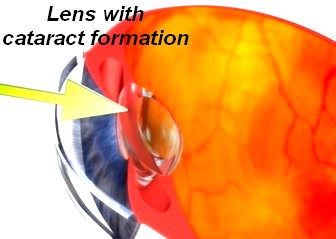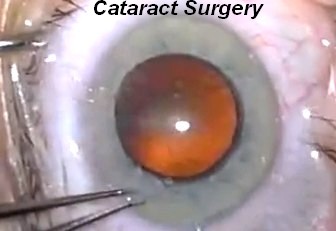Table 18.1 Nomenclature of bone tumors
Cataracts
BASIC INFORMATION
DEFINITION
This is a clouding of the lens sufficient to reduce vision. Most cataracts develop slowly as a result of aging, leading to gradual impairment of vision. The formation of cataract occurs more rapidly in patients with a history of ocular trauma, uveitis, or diabetes mellitus. Cataracts are acquired in a variety of genetic diseases, such as myotonic dystrophy, neurofibromatosis type 2, and galactosemia. Radiation therapy and glucocorticoid treatment can induce cataract as a side effect. The cataracts associated with radiation or glucocorticoids have a typical posterior subcapsular location. Cataract can be detected by noting an impaired red reflex when viewing light reflected from the fundus with an ophthalmoscope or by examining the dilated eye using the slit lamp.
The only treatment for cataract is surgical extraction of the opacified lens. Over a million cataract operations are performed each year in the United States. The operation is generally done under local anesthesia on an outpatient basis. A plastic or silicone intraocular lens is placed within the empty lens capsule in the posterior chamber, substituting for the natural lens and leading to rapid recovery of sight. More than 95% of patients who undergo cataract extraction can expect an improvement in vision. In some patients, the lens capsule remaining in the eye after cataract extraction eventually turns cloudy, causing secondary loss of vision. A small opening is made in the lens capsule with a laser to restore clarity.
SYNONYMS
Congenital cataracts (e.g., from rubella)
Metabolic cataracts (e.g., caused by diabetes)
Collagen-vascular disease cataracts (caused by lupus)
Hereditary cataracts
Age-related senile cataracts
Traumatic cataracts
Toxic or drug-induced cataracts (e.g., caused by steroids)
EPIDEMIOLOGY & DEMOGRAPHICS
INCIDENCE (IN U.S.): Highest cause of treatable blindness; cataract removal most frequent surgical procedure in patients >65 years old (1.3 million operations/yr, with an annual cost of approximately $3 billion).
PREDOMINANT AGE: Elderly; some stage of cataract development is present in >55% of persons 65 to 74 years old and 67% of those >75 years old.
PEAK INCIDENCE:
• In early life: congenital and hereditary causes predominant
• In older age group: senile cataracts (after 40 years of age)
GENETICS: Hereditary with such syndromes as galactosemia, homocystinuria, diabetes
PHYSICAL FINDINGS & CLINICAL PRESENTATION
Cloudiness and opacification of the crystalline lens of the eye
ETIOLOGY
• Heredity
• Trauma
• Toxins
• Age-related
• Drug-related
• Congenital
• Inflammatory
DIAGNOSIS
DIFFERENTIAL DIAGNOSIS
• Corneal lesions
• Retinal lesions
WORKUP
Complete eye examination, including slit lamp examination, funduscopic examination, and brightness acuity testing
LABORATORY TESTS
• Rarely, urinary amino acid screening and CNS imaging studies with congenital cataracts
• Fasting glucose in young adults with cataracts
TREATMENT
NONPHARMACOLOGIC THERAPY
• Wait until vision is compromised before doing surgery.
• Surgery is indicated when corrected visual acuity in the affected eye is >20/30 in the absence of other ocular disease; however, surgery may be justified when visual acuity is better in specific situations (especially disabling glare, monocular diplopia).
ACUTE GENERAL Rx
None necessary
CHRONIC Rx
• Change glasses as cataracts develop.
• Myopia is common, and glasses can be adjusted until surgery is contemplated.
DISPOSITION
Refer if sight compromised.
Congenital cataracts (e.g., from rubella)
Metabolic cataracts (e.g., caused by diabetes)
Collagen-vascular disease cataracts (caused by lupus)
Hereditary cataracts
Age-related senile cataracts
Traumatic cataracts
Toxic or drug-induced cataracts (e.g., caused by steroids)
EPIDEMIOLOGY & DEMOGRAPHICS
INCIDENCE (IN U.S.): Highest cause of treatable blindness; cataract removal most frequent surgical procedure in patients >65 years old (1.3 million operations/yr, with an annual cost of approximately $3 billion).
PREDOMINANT AGE: Elderly; some stage of cataract development is present in >55% of persons 65 to 74 years old and 67% of those >75 years old.
PEAK INCIDENCE:
• In early life: congenital and hereditary causes predominant
• In older age group: senile cataracts (after 40 years of age)
GENETICS: Hereditary with such syndromes as galactosemia, homocystinuria, diabetes
PHYSICAL FINDINGS & CLINICAL PRESENTATION
Cloudiness and opacification of the crystalline lens of the eye
ETIOLOGY
• Heredity
• Trauma
• Toxins
• Age-related
• Drug-related
• Congenital
• Inflammatory
DIAGNOSIS
DIFFERENTIAL DIAGNOSIS
• Corneal lesions
• Retinal lesions
WORKUP
Complete eye examination, including slit lamp examination, funduscopic examination, and brightness acuity testing
LABORATORY TESTS
• Rarely, urinary amino acid screening and CNS imaging studies with congenital cataracts
• Fasting glucose in young adults with cataracts
TREATMENT
NONPHARMACOLOGIC THERAPY
• Wait until vision is compromised before doing surgery.
• Surgery is indicated when corrected visual acuity in the affected eye is >20/30 in the absence of other ocular disease; however, surgery may be justified when visual acuity is better in specific situations (especially disabling glare, monocular diplopia).
ACUTE GENERAL Rx
None necessary
CHRONIC Rx
• Change glasses as cataracts develop.
• Myopia is common, and glasses can be adjusted until surgery is contemplated.
DISPOSITION
Refer if sight compromised.


Contacts: lubopitno_bg@abv.bg www.encyclopedia.lubopitko-bg.com Corporation. All rights reserved.
DON'T FORGET - KNOWLEDGE IS EVERYTHING!